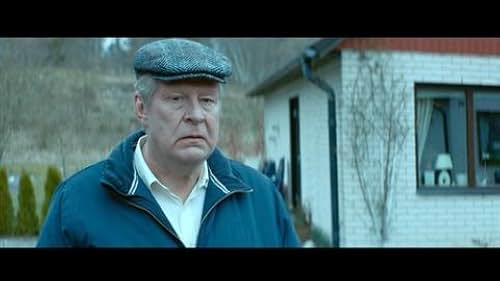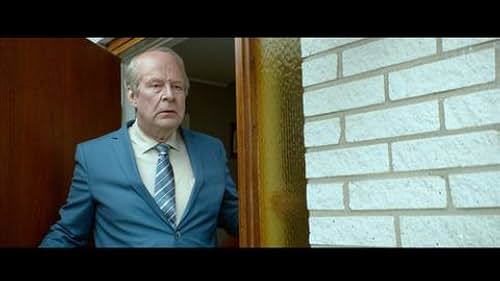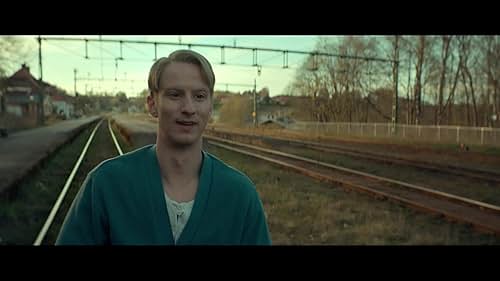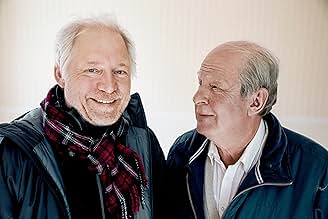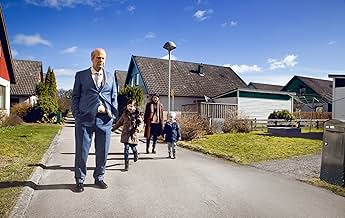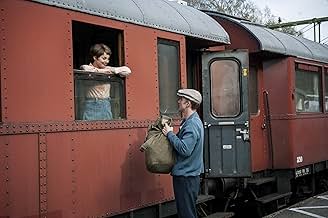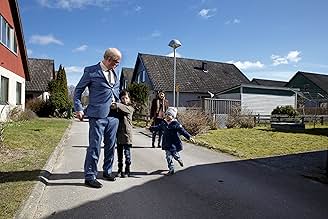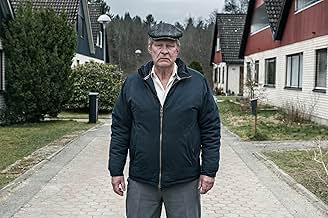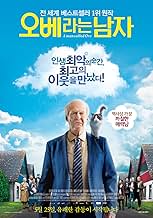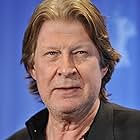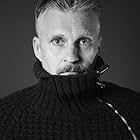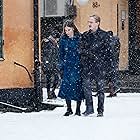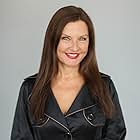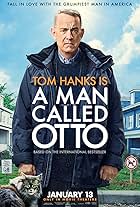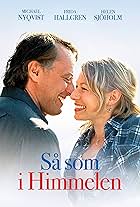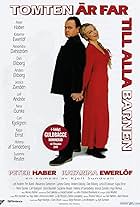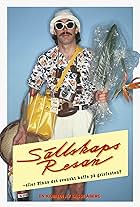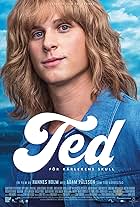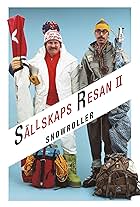Ove, an ill-tempered, isolated retiree who spends his days enforcing block association rules and visiting his wife's grave, has finally given up on life just as an unlikely friendship develo... Read allOve, an ill-tempered, isolated retiree who spends his days enforcing block association rules and visiting his wife's grave, has finally given up on life just as an unlikely friendship develops with his boisterous new neighbors.Ove, an ill-tempered, isolated retiree who spends his days enforcing block association rules and visiting his wife's grave, has finally given up on life just as an unlikely friendship develops with his boisterous new neighbors.
- Nominated for 2 Oscars
- 15 wins & 29 nominations total
- Director
- Writers
- All cast & crew
- Production, box office & more at IMDbPro
Storyline
Did you know
- TriviaTwo different Ragdoll cats, Magic and Orlando, were used in the movie. During casting, Magic was selected due to his adherence, curiousness and because he could never be startled away. Orlando was a stand-in used for the scenes when the cat was required to stay put or to be carried for long periods of time. Both cats were born in Poland.
- GoofsAt around 53:48, when Ove is on the platform the clock shows 6:45am. When he comes back home to rescue the cat and goes upstairs, the little alarm clock shows 6:20am.
- ConnectionsFeatured in The Oscars (2017)
- SoundtracksBlott en dag
Music by Oscar Ahnfelt (uncredited)
Lyrics by Lina Sandell (uncredited)
[Incorrectly credited as Traditional]
Performed by Stockholms Symfoniorkester (Stockholm Symphony Orchestra)
(p) 2011 Naxos AB
Featured review
When accepting the Best Foreign-Language Film award for Parasite at the 2020 Golden Globes, Director Bong Joon-ho said, "Once you overcome the 1-inch-tall barrier of subtitles, you will be introduced to so many more amazing films."
The reason why I bring up this quote is that there are many great films that just happen to be in a different language. This shouldn't be a detriment to the viewers. After all, there's a reason why we say we're watching a movie, instead of listening to it or reading it. If one looks past the subtitles, they will be able to access more excellent flicks. A great example of this is the 2015 two-time Oscar nominated Swedish movie "A Man Called Ove" due to the simple and effective translation of the book of the same name by Fredrik Backman to the screen.
Since 2012, the book has achieved popularity and retained a cultural legacy in the world of literature due to the deep and simple depiction of a curmudgeon finding ways to heal with the unlikeliest people in the unlikeliest ways. Director and writer Hannes Holm understood this when adapting this through various aspects like cinematography, the transitions, and where to place the big emotional beats. The look of the flick involves drab and bright colors, but they are used as a reflection of Ove's state of mind. In the beginning of the movie when Ove (played by Rolf Lassgård) is inspecting the neighborhood and later whenever he feels depressed, there's a blue tint that clouds the environment. Then, whenever he helps someone like the new neighbors, it brightens up. While this can come off as an obvious way to show how the main character is opening up and healing, it's not blasted into the viewers' faces because Holmes always ensures that the focus is on Ove and his thoughts.
Another element that works beautifully in the film is how it transitions into the flashbacks. Because the novel heavily relies on the stream-of-consciousness device, the movie utilizes this whenever Ove tries to take his own life. Specifically, it flashes back to various moments of Ove's past that get triggered through a variety of things like a conversation with Parvaneh - the pregnant Iranian neighbor (played by Bahar Pars). Then, these thoughts get interrupted when someone needs assistance. Even though I don't remember how the suicide attempts are depicted in the book, they are portrayed somberly in the movie, while the interruptions are more comical. Granted, these scenes can become predictable if the movie was in the wrong hands. Luckily, Holmes makes them into dreams that get disrupted whenever someone wants help. For example, when Ove attempts to take his own life the first time, Parvaneh calls on him to help direct her Swedish husband Patrick as he drives into the neighborhood. As a result, viewers know that someone is going to stand in the way of Ove and his suicide attempts, but the movie is so invested in the flashbacks that it comes as an rude awakening when someone needs Ove's help. This is where the humor comes from.
While the film has its quirky scenes, it's a tearjerker too, and it's another element that it does well. A lot of the emotional scenes take place during the flashbacks. These include the fire at Ove's childhood home and the bomb that goes off on the bus while Ove and his wife Sonja are on vacation. These are usually placed 20 minutes of each other, which allows viewers to think about what they saw and how it affects Ove in the present day while chuckling at various antics like him teaching Parvaneh how to drive. As much as I like the 1939 version of "Goodbye, Mr. Chips," it tries to wring out tears from audiences every 5 minutes, which gets tiring after a while. Speaking of that film, Sonja is like Katherine since both become the person that the titular characters love the most and are able to turn the titular characters' lives around. The main difference is that Sonja's presence remains constant even when she is not on screen because of how Ove constantly thinks of her. This permits audiences to form an emotional attachment to the character and feel the impact of the stuff that occurs to the two characters. Katherine is only present for 20 minutes in "Goodbye, Mr. Chips," and she is barely referred to after she dies despite Chips truly loving her. As a result, audiences don't feel the impact of Katherine and her influence on Chips in the same way that they do for Sonja and her effect on Ove.
And now, I must talk about the strongest aspect of this movie adaptation: the performances. All of the actors do a good job of capturing the spirit of their characters, but of course, I have to single out a few of them. The first is Bahar Pars who plays Parvaneh. Pars played her character as pushy and determined but caring, especially when she wants specifically Ove to help her out. If in lesser hands, Parvaneh could become a nagger, which can become one note very easily. This doesn't happen with Pars as she allows the character to display her caring side, especially when she gets to know Ove more. It also helps that Par and Lassgård have good chemistry with each other, which permits the characters' relationship to evolve naturally.
Ida Engvoll plays Sonja - Ove's wife. She mainly appears in the flashbacks with a younger Ove (played by Filip Berg). Engvoll portrays her as sophisticated, but with a sassy smile and a determination to help others as a teacher. There's also a no-nonsense element to her performance, which makes Ove's attraction to her all the more believable. This is especially true when Sonja out of the blue says that Ove will be a good father.
As mentioned earlier, Filip Berg plays the younger Ove in the flashbacks. Berg brings kindness and awkwardness to the character, showing how he was before all the tragedies occurred. At first, Anglo-American viewers might think that he might be either George or Fred Weasley from the Harry Potter movies, but his deep baritone voice dispels any notion and matches that of Lassgård's. Both Berg and Engvoll have good chemistry, which make their characters' love for each other more believable.
As much as everyone performs well in this movie, the strongest one undoubtedly belongs to Rolf Lassgård who plays the older titular character. The way he moves and speaks all embody a curmudgeon, but above all, he makes Ove more into a person that people can identify with than a caricature. Through his performance, Lassgård makes it clear that Ove fears being lonely and without purpose. Over the duration of the movie, Lassgård lightens up on Ove's curmudgeon ways while not entirely discarding them as the character helps others and opens up about his life and Sonja. The best indication of this emotional transformation is Lassgård smiling in the later parts of the movie when he's with Parvaneh or her daughters. Speaking of transformation, I have to talk about the makeup on Lassgård. Both him and Ove are 59 years old, but in the flick, Lassgård is made to look much older. This makes sense as the world has weighed Ove down so much that he has aged more. I didn't even realize that he had makeup on until I looked at actual photos of Lassgård, who has a full head of hair, and Ove has his balding gray tresses. The way that Lassgård is made up looks very realistic, and I can now understand why Eva Von Bahr and Love Larson got the nomination for Best Makeup at the 2016 Oscars. They deserved it.
In summary, the film adaptation of "A Man Called Ove" proves that great movies can come from other languages because of its deep and simple nature. Holmes truly understood the spirit of the novel and conveyed that in a variety of ways, but the strongest element of the film are performances as it should be with a simple story like this. I can definitely see why the Academy decided to nominate it for Best Makeup and Best Foreign-Language Film at the 2016 Oscars. Like the novel, I recommend the flick to everybody as long as they don't let the subtitles get in the way.
The reason why I bring up this quote is that there are many great films that just happen to be in a different language. This shouldn't be a detriment to the viewers. After all, there's a reason why we say we're watching a movie, instead of listening to it or reading it. If one looks past the subtitles, they will be able to access more excellent flicks. A great example of this is the 2015 two-time Oscar nominated Swedish movie "A Man Called Ove" due to the simple and effective translation of the book of the same name by Fredrik Backman to the screen.
Since 2012, the book has achieved popularity and retained a cultural legacy in the world of literature due to the deep and simple depiction of a curmudgeon finding ways to heal with the unlikeliest people in the unlikeliest ways. Director and writer Hannes Holm understood this when adapting this through various aspects like cinematography, the transitions, and where to place the big emotional beats. The look of the flick involves drab and bright colors, but they are used as a reflection of Ove's state of mind. In the beginning of the movie when Ove (played by Rolf Lassgård) is inspecting the neighborhood and later whenever he feels depressed, there's a blue tint that clouds the environment. Then, whenever he helps someone like the new neighbors, it brightens up. While this can come off as an obvious way to show how the main character is opening up and healing, it's not blasted into the viewers' faces because Holmes always ensures that the focus is on Ove and his thoughts.
Another element that works beautifully in the film is how it transitions into the flashbacks. Because the novel heavily relies on the stream-of-consciousness device, the movie utilizes this whenever Ove tries to take his own life. Specifically, it flashes back to various moments of Ove's past that get triggered through a variety of things like a conversation with Parvaneh - the pregnant Iranian neighbor (played by Bahar Pars). Then, these thoughts get interrupted when someone needs assistance. Even though I don't remember how the suicide attempts are depicted in the book, they are portrayed somberly in the movie, while the interruptions are more comical. Granted, these scenes can become predictable if the movie was in the wrong hands. Luckily, Holmes makes them into dreams that get disrupted whenever someone wants help. For example, when Ove attempts to take his own life the first time, Parvaneh calls on him to help direct her Swedish husband Patrick as he drives into the neighborhood. As a result, viewers know that someone is going to stand in the way of Ove and his suicide attempts, but the movie is so invested in the flashbacks that it comes as an rude awakening when someone needs Ove's help. This is where the humor comes from.
While the film has its quirky scenes, it's a tearjerker too, and it's another element that it does well. A lot of the emotional scenes take place during the flashbacks. These include the fire at Ove's childhood home and the bomb that goes off on the bus while Ove and his wife Sonja are on vacation. These are usually placed 20 minutes of each other, which allows viewers to think about what they saw and how it affects Ove in the present day while chuckling at various antics like him teaching Parvaneh how to drive. As much as I like the 1939 version of "Goodbye, Mr. Chips," it tries to wring out tears from audiences every 5 minutes, which gets tiring after a while. Speaking of that film, Sonja is like Katherine since both become the person that the titular characters love the most and are able to turn the titular characters' lives around. The main difference is that Sonja's presence remains constant even when she is not on screen because of how Ove constantly thinks of her. This permits audiences to form an emotional attachment to the character and feel the impact of the stuff that occurs to the two characters. Katherine is only present for 20 minutes in "Goodbye, Mr. Chips," and she is barely referred to after she dies despite Chips truly loving her. As a result, audiences don't feel the impact of Katherine and her influence on Chips in the same way that they do for Sonja and her effect on Ove.
And now, I must talk about the strongest aspect of this movie adaptation: the performances. All of the actors do a good job of capturing the spirit of their characters, but of course, I have to single out a few of them. The first is Bahar Pars who plays Parvaneh. Pars played her character as pushy and determined but caring, especially when she wants specifically Ove to help her out. If in lesser hands, Parvaneh could become a nagger, which can become one note very easily. This doesn't happen with Pars as she allows the character to display her caring side, especially when she gets to know Ove more. It also helps that Par and Lassgård have good chemistry with each other, which permits the characters' relationship to evolve naturally.
Ida Engvoll plays Sonja - Ove's wife. She mainly appears in the flashbacks with a younger Ove (played by Filip Berg). Engvoll portrays her as sophisticated, but with a sassy smile and a determination to help others as a teacher. There's also a no-nonsense element to her performance, which makes Ove's attraction to her all the more believable. This is especially true when Sonja out of the blue says that Ove will be a good father.
As mentioned earlier, Filip Berg plays the younger Ove in the flashbacks. Berg brings kindness and awkwardness to the character, showing how he was before all the tragedies occurred. At first, Anglo-American viewers might think that he might be either George or Fred Weasley from the Harry Potter movies, but his deep baritone voice dispels any notion and matches that of Lassgård's. Both Berg and Engvoll have good chemistry, which make their characters' love for each other more believable.
As much as everyone performs well in this movie, the strongest one undoubtedly belongs to Rolf Lassgård who plays the older titular character. The way he moves and speaks all embody a curmudgeon, but above all, he makes Ove more into a person that people can identify with than a caricature. Through his performance, Lassgård makes it clear that Ove fears being lonely and without purpose. Over the duration of the movie, Lassgård lightens up on Ove's curmudgeon ways while not entirely discarding them as the character helps others and opens up about his life and Sonja. The best indication of this emotional transformation is Lassgård smiling in the later parts of the movie when he's with Parvaneh or her daughters. Speaking of transformation, I have to talk about the makeup on Lassgård. Both him and Ove are 59 years old, but in the flick, Lassgård is made to look much older. This makes sense as the world has weighed Ove down so much that he has aged more. I didn't even realize that he had makeup on until I looked at actual photos of Lassgård, who has a full head of hair, and Ove has his balding gray tresses. The way that Lassgård is made up looks very realistic, and I can now understand why Eva Von Bahr and Love Larson got the nomination for Best Makeup at the 2016 Oscars. They deserved it.
In summary, the film adaptation of "A Man Called Ove" proves that great movies can come from other languages because of its deep and simple nature. Holmes truly understood the spirit of the novel and conveyed that in a variety of ways, but the strongest element of the film are performances as it should be with a simple story like this. I can definitely see why the Academy decided to nominate it for Best Makeup and Best Foreign-Language Film at the 2016 Oscars. Like the novel, I recommend the flick to everybody as long as they don't let the subtitles get in the way.
- How long is A Man Called Ove?Powered by Alexa
Details
- Release date
- Countries of origin
- Official site
- Languages
- Also known as
- Un hombre llamado Ove
- Filming locations
- Production companies
- See more company credits at IMDbPro
Box office
- Budget
- €4,000,000 (estimated)
- Gross US & Canada
- $3,479,315
- Opening weekend US & Canada
- $54,608
- Oct 2, 2016
- Gross worldwide
- $30,726,624
- Runtime1 hour 56 minutes
- Color
- Sound mix
- Aspect ratio
- 2.35 : 1
Contribute to this page
Suggest an edit or add missing content


